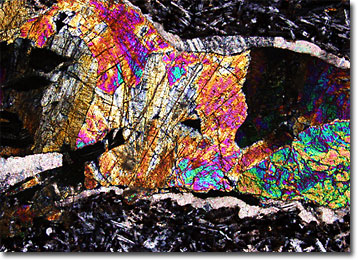Polarized Light Microscopy Digital Image Gallery
Amygdaloidal Basalt
Basalt, which is one of the most prevalent rock types on Earth, is of volcanic origin. Relatively rich in iron and magnesium, the name of the rock is believed to stem form the Ethiopian term basal, meaning “a rock from which iron can be derived.”

The appearance and structure of basalts may vary significantly, though they are typically dark gray or black in color. Found worldwide amid the oceans as well as the continents, the rocks form when a certain type of magma cools and hardens. Sometimes the result is a smooth, glassy rock, while other samples may instead display a porphyritic structure. Basalts may also be spongy or amygdaloidal. This latter form of the rock occurs due to the deposition of secondary minerals, such as calcite or quartz, in gas bubbles that become trapped within the rock during the cooling process. The term amygdaloidal refers to the characteristic shape of the mineral deposits, stemming from the Latin word amygdala, meaning “almond.”
Though not generally considered one of the more aesthetically pleasing rocks, basalt was the inspiration for a line of stoneware generated by the English potter Josiah Wedgwood. Black, unglazed, and mutely polished, the stately Wedgwood basalt, also known as Egyptian ware, entered the market around 1768. Though sometimes appearing in the form of tea sets and dishes, more often the dark pottery could be found as candlesticks, bookends, plaques, figurines, sculptures, and vases. These items were typically decorated in the neoclassical style that was popular during the period.
